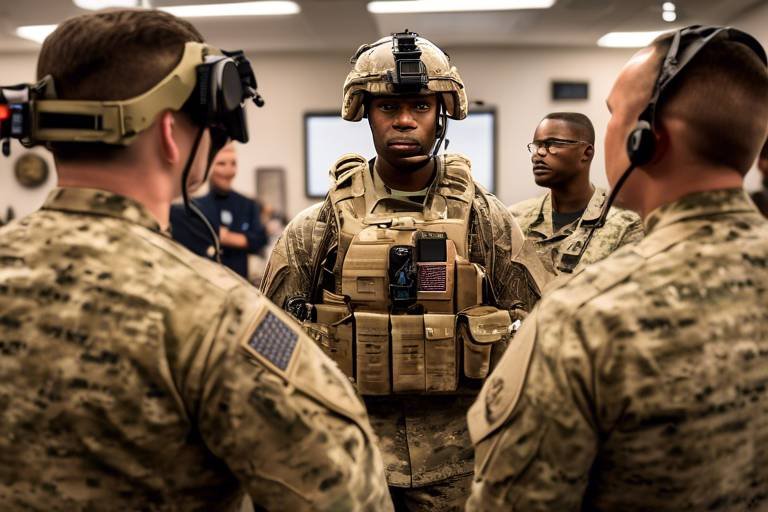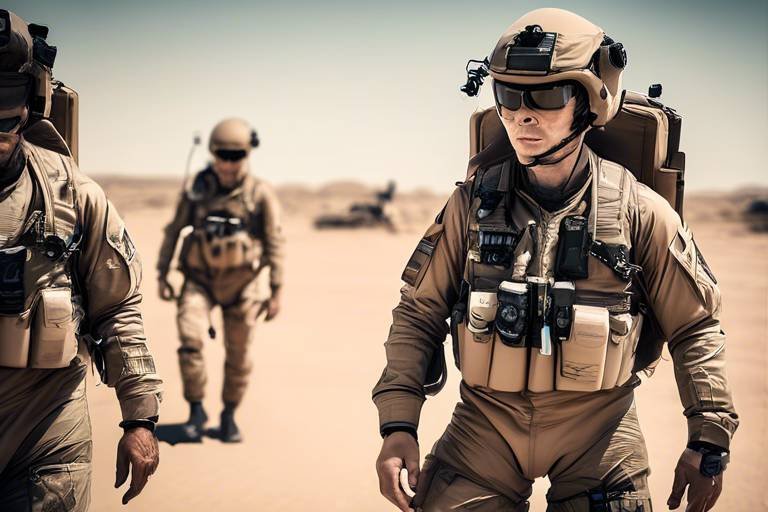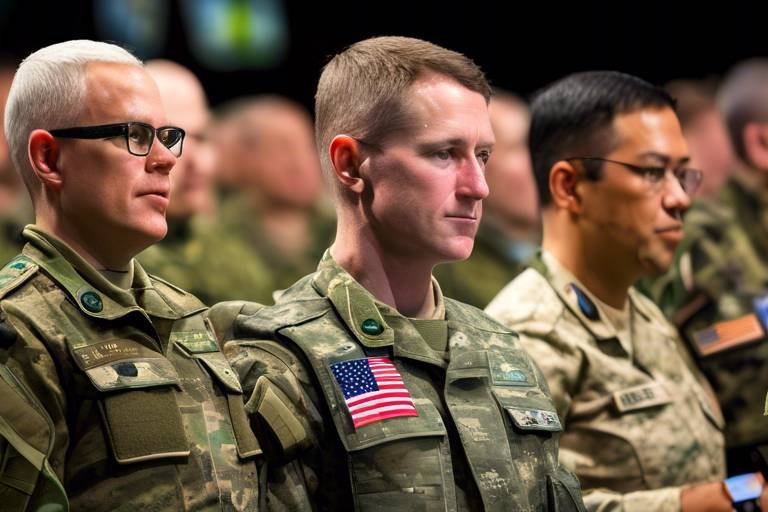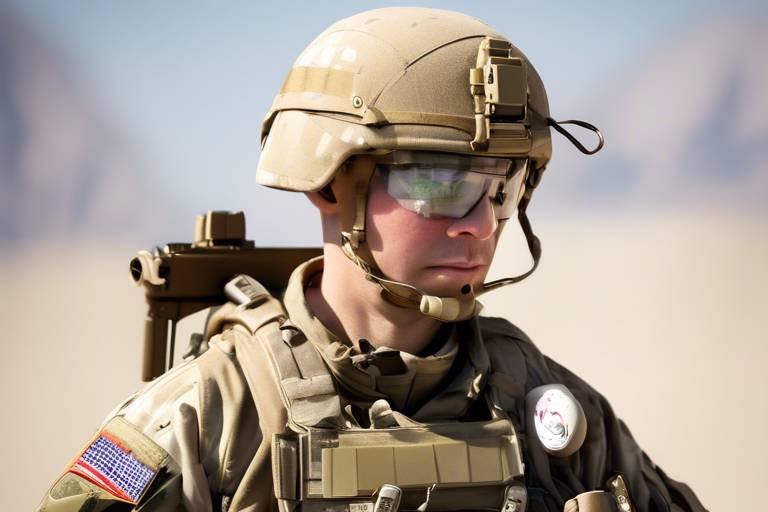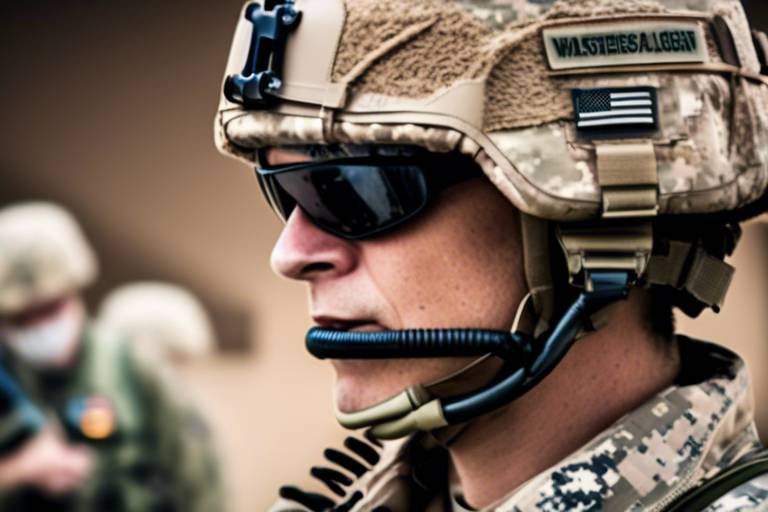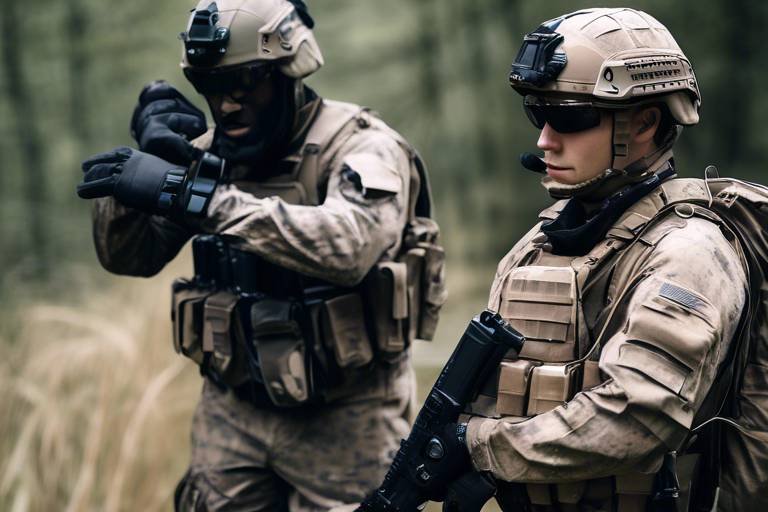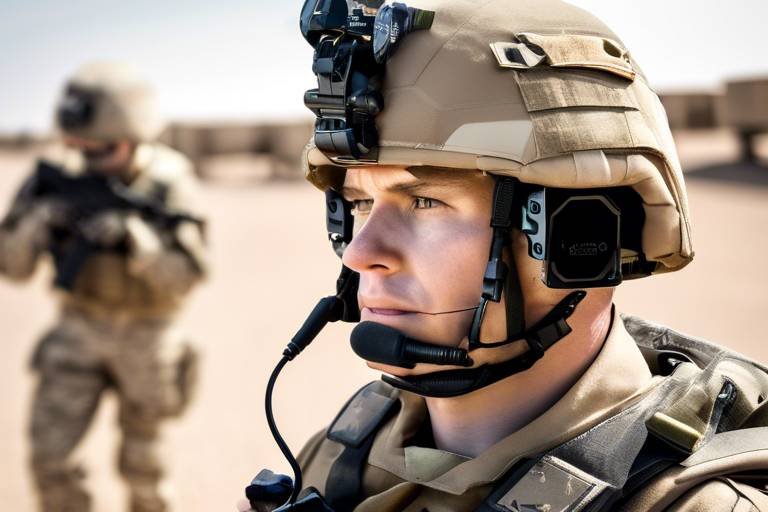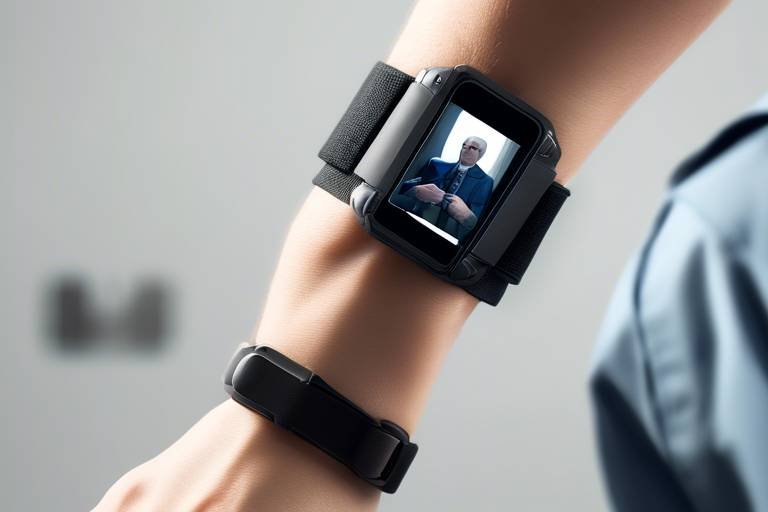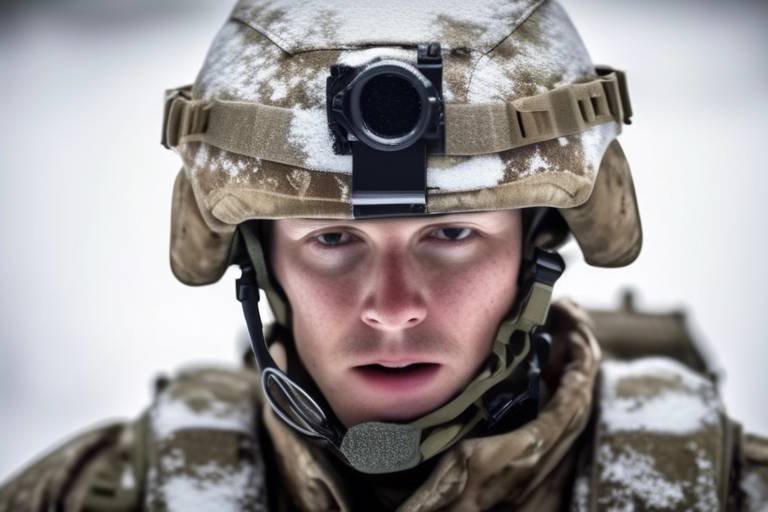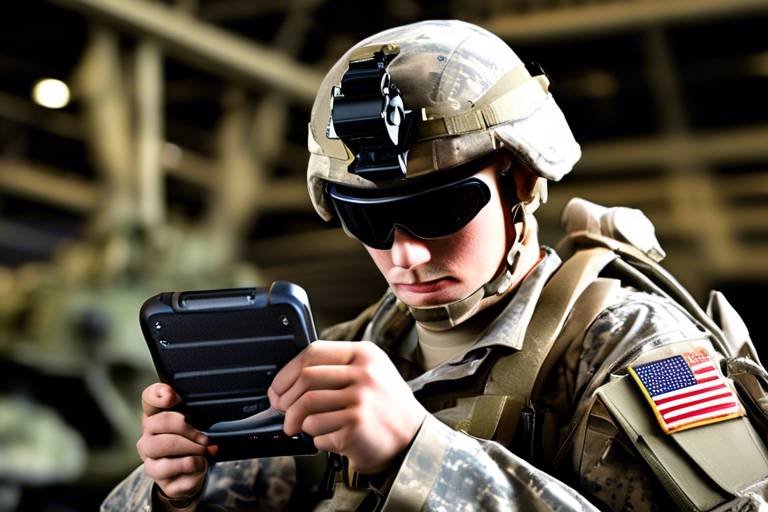How Wearables Enhance Collaboration Among Military Branches
In today's fast-paced world, where every second counts, the military is embracing wearable technology to revolutionize the way different branches communicate and collaborate. Imagine soldiers on the battlefield, equipped with smart devices that not only keep them connected but also provide real-time data that can be crucial for mission success. It's not just about staying in touch; it's about enhancing operational efficiency, improving safety, and fostering a culture of teamwork that transcends traditional boundaries. As we delve into the remarkable impact of wearables, we'll uncover how these innovative tools are reshaping military operations and paving the way for a more integrated defense strategy.
The journey of wearable technology in the military is nothing short of fascinating. Initially, wearables were viewed as mere gadgets, but their potential quickly became evident. From fitness trackers to advanced communication devices, the evolution of wearables has been driven by the need for enhanced performance and safety in high-stakes environments. Today, military personnel can leverage a variety of devices that not only monitor their health but also provide critical information on the battlefield. This evolution has led to widespread adoption across various military contexts, transforming how soldiers prepare for and engage in operations.
One of the most significant advantages of wearable technology is its ability to facilitate real-time communication and data sharing among military personnel. Imagine a scenario where a squad is deep in enemy territory, and they need to communicate vital information instantly. Wearable devices streamline this process, allowing messages and data to flow seamlessly, which is crucial during missions. This capability not only enhances operational efficiency but also fosters collaboration, ensuring that every member of the team is on the same page. With wearables, the traditional barriers of communication are being dismantled, leading to a more cohesive unit.
Wearable devices equipped with GPS technology enable precise location tracking of troops, which is invaluable during operations. Knowing where every team member is located can make all the difference in a high-pressure situation. For instance, if a soldier is injured, immediate location tracking allows for a swift response from medics, significantly improving the chances of survival. Moreover, this level of location awareness enhances coordination among units, ensuring that everyone is aware of their surroundings and can act accordingly. It's like having a detailed map in your pocket, guiding you through the complexities of the battlefield.
Wearables provide crucial situational updates that allow military personnel to make informed decisions quickly. Picture this: a commander receives real-time updates about enemy movements and troop statuses directly on their wrist. This kind of enhanced awareness is vital for mission success and personnel safety. By having access to up-to-date information, military leaders can adapt their strategies on the fly, responding to changing conditions with agility and precision. In essence, wearables are transforming how decisions are made, turning what was once a reactive process into a proactive one.
The integration of data analytics in wearable technology empowers military leaders to make strategic decisions based on actionable insights. For example, by analyzing data collected from wearables, commanders can identify patterns in troop performance, health metrics, and even environmental conditions. This data-driven approach enhances operational planning and execution, allowing for more effective resource allocation and risk management. It's akin to having a strategic advisor embedded in every soldier's gear, providing real-time feedback that can lead to more successful missions.
Wearable technology fosters collaboration between different military branches by ensuring seamless communication. Whether it's the Army coordinating with the Navy or the Air Force working alongside the Marines, wearables break down silos and promote interoperability. Imagine joint operations where every branch can share information instantly, leading to a more unified effort. This level of collaboration not only enhances operational effectiveness but also builds trust among different branches, creating a more cohesive military force ready to tackle any challenge.
Despite the myriad advantages, implementing wearable technology in the military is not without its challenges. Issues such as cybersecurity threats and integration complexities can hinder the full potential of these devices. Understanding these obstacles is crucial for developing effective solutions that ensure the safe and efficient use of wearables in military operations.
The use of wearables raises significant cybersecurity challenges, as sensitive data may be vulnerable to breaches. With military operations relying heavily on technology, protecting this information is paramount. Robust security measures must be implemented to safeguard against potential threats, ensuring that the information shared through wearables remains confidential and secure. It's a constant battle, much like a chess game, where every move must be calculated to stay one step ahead of potential adversaries.
Integrating wearable technology with current military systems can be complex. The technical challenges of ensuring compatibility with legacy systems can slow down the adoption process. However, with strategic planning and collaboration between tech developers and military personnel, achieving seamless integration is possible. This not only maximizes the benefits of wearables but also enhances overall operational efficiency. The key lies in fostering an environment where technology and military expertise can work hand in hand.
- What types of wearable technology are used in the military? Wearable technology in the military includes smartwatches, fitness trackers, GPS devices, and communication headsets.
- How does wearable technology improve safety for military personnel? Wearables enhance safety by providing real-time location tracking and situational awareness, allowing for quick responses in emergencies.
- What are the main challenges of using wearables in military operations? Major challenges include cybersecurity threats and the integration of wearables with existing military systems.
- Can wearables be used for inter-branch collaboration? Yes, wearables facilitate seamless communication and data sharing, enhancing collaboration between different military branches.
The Rise of Wearable Technology in the Military
Wearable technology has swiftly transitioned from the realm of consumer gadgets to a pivotal tool in military operations. Imagine a world where soldiers are not just equipped with weapons, but also with smart technology that enhances their capabilities on the battlefield. This evolution has been fueled by the need for improved communication, real-time data sharing, and enhanced situational awareness. In recent years, various branches of the military have embraced wearables, integrating them into their operational frameworks.
The adoption of wearables began as a response to the challenges posed by modern warfare. As conflicts become more complex and multi-faceted, the military recognized that traditional communication methods were not sufficient. Wearable devices, such as smart helmets, tactical vests, and wrist-mounted displays, have emerged as game-changers. These devices are designed to provide soldiers with critical information at their fingertips, allowing them to make quicker, more informed decisions.
One of the key drivers behind the rise of wearables in the military is the advancement of sensor technology. Sensors embedded in these devices can monitor a soldier's vital signs, environmental conditions, and even the status of their equipment. This data is not only valuable for individual soldiers but also for command units that require a comprehensive overview of the battlefield. The information gathered can be analyzed in real-time, leading to improved strategic planning and execution.
Furthermore, the integration of wearables into military operations is not just about enhancing individual performance; it's about fostering a culture of collaboration among different military branches. With the ability to share information seamlessly, soldiers from the Army, Navy, Air Force, and Marines can work together more effectively. This interoperability is crucial, especially in joint operations where coordination is key to success.
To illustrate the impact of wearables, consider the following table that outlines some of the most common types of wearable technology currently being utilized in the military:
| Device Type | Purpose | Key Features |
|---|---|---|
| Smart Helmets | Heads-up display for situational awareness | Augmented reality, communication tools, night vision |
| Tactical Vests | Integrated with sensors and communication devices | Health monitoring, GPS tracking, data sharing |
| Wrist-Mounted Displays | Quick access to mission data | Touchscreen interface, connectivity with other devices |
As we look to the future, the potential of wearable technology in the military seems limitless. With ongoing advancements in technology and a growing emphasis on data-driven decision-making, we can expect to see even more innovative applications of wearables. The military's commitment to enhancing operational efficiency through technology not only prepares them for current challenges but also sets the stage for future advancements that could redefine warfare.
Improved Communication and Data Sharing
In today's fast-paced military operations, the ability to communicate effectively and share data in real-time is not just an advantage; it's a necessity. Wearable technology has emerged as a game-changer in this arena, enabling seamless communication among military personnel. Imagine being on a mission where every second counts, and the information you receive is crucial for your team's success. Wearables make that possible by providing instant access to vital data, ensuring that everyone is on the same page.
These devices, often equipped with advanced sensors and connectivity features, allow soldiers to share information instantly, whether they are in the field or stationed at a command center. For instance, a soldier can receive live updates on enemy positions or changing mission parameters directly on their wrist. This not only enhances operational efficiency but also fosters a sense of unity among team members, as everyone is equipped with the same critical information.
Moreover, the integration of wearable technology into military operations facilitates better data flow. With wearables, information can be transmitted in real-time, significantly reducing the lag that often occurs with traditional communication methods. This rapid data sharing can be the difference between success and failure in high-stakes situations. For example, during joint operations involving multiple branches of the military, wearables ensure that all parties involved have access to the same intelligence, allowing for coordinated efforts and strategic planning.
To illustrate the impact of wearables on communication and data sharing, consider the following benefits:
- Instant Updates: Soldiers receive timely information about mission changes, enemy movements, and environmental conditions.
- Enhanced Coordination: Wearables allow for synchronized actions among different units, improving overall mission effectiveness.
- Reduced Miscommunication: By providing a single source of truth, wearables minimize the chances of errors that can arise from verbal communication.
Furthermore, the data collected through wearables can be analyzed to identify patterns and improve future operations. For instance, after a mission, leaders can review the data to assess what strategies worked and what didn't, leading to better planning in future missions. This data-driven approach not only enhances current operations but also contributes to the evolution of military tactics over time.
In conclusion, wearable technology is revolutionizing how military personnel communicate and share data. By enhancing real-time communication and ensuring that everyone has access to the same information, wearables are not just tools; they are vital components of modern military operations. As we look to the future, the integration of these technologies will only deepen, paving the way for even more effective collaboration and operational success.
Real-Time Location Tracking
In the fast-paced world of military operations, has emerged as a game-changer, revolutionizing how troops coordinate and execute their missions. Imagine a battlefield where every soldier’s position is known, allowing for precise movements and strategic planning. This is not just a futuristic dream; it’s the reality brought about by advanced wearable technology.
Wearable devices, such as smartwatches and tactical vests equipped with GPS capabilities, enable military personnel to share their locations with command centers and fellow soldiers instantly. This enhanced visibility is crucial for several reasons:
- Improved Coordination: Knowing the exact location of each unit allows for better tactical maneuvers, reducing the risk of friendly fire and ensuring that support units can reach their comrades swiftly.
- Increased Safety: Real-time tracking helps in monitoring the safety of personnel, especially in hostile environments. If a soldier goes off the grid, immediate action can be taken to locate and assist them.
- Efficient Resource Allocation: Commanders can make informed decisions about where to deploy resources, ensuring that help is dispatched to the most critical areas without delay.
Moreover, the integration of location tracking with other data sources enhances situational awareness. For instance, when combined with environmental data, commanders can assess how terrain and weather conditions affect troop movements. This holistic view is invaluable for making quick, informed decisions that can mean the difference between mission success and failure.
However, it’s essential to acknowledge that while real-time location tracking provides numerous benefits, it also raises questions about privacy and security. Military personnel must trust that their location data is secure and used responsibly. Therefore, implementing robust cybersecurity measures is crucial to protect this sensitive information from potential threats.
In conclusion, real-time location tracking through wearable technology is not just a convenience; it’s a necessity in modern military operations. By providing critical insights into troop movements, it enhances coordination, safety, and overall operational efficiency. As technology continues to evolve, the potential for even more sophisticated tracking systems will undoubtedly reshape the future of military collaboration.
- What types of wearable devices are used in the military?
Wearable devices in the military include smartwatches, tactical vests with embedded sensors, and body cameras that provide real-time data and communication capabilities. - How does real-time location tracking improve mission success?
It enhances coordination among troops, reduces the risk of friendly fire, and allows for quick response to emergencies, ultimately contributing to mission success. - What are the cybersecurity risks associated with wearable technology?
Wearable devices can be vulnerable to hacking and data breaches, making it essential to implement strong security measures to protect sensitive military information.
Enhanced Situational Awareness
In the fast-paced world of military operations, situational awareness is not just a buzzword; it’s a critical component that can mean the difference between success and failure. Wearable technology has revolutionized how military personnel perceive their surroundings, allowing them to stay informed and agile in dynamic environments. Imagine being in the thick of a mission, where every second counts, and having access to real-time updates right on your wrist. This is the power of wearables!
Wearables equipped with advanced sensors and communication tools provide crucial situational updates that help soldiers make informed decisions quickly. For instance, a soldier on the ground can receive instant alerts about enemy movements or changes in mission parameters, all while keeping their hands free for critical tasks. This capability enhances not only individual performance but also the overall effectiveness of the unit.
Moreover, the integration of augmented reality (AR) into wearables is taking situational awareness to new heights. Imagine wearing a headset that overlays vital information directly onto your field of vision. This technology allows soldiers to see maps, troop locations, and even potential threats without having to look away from their immediate surroundings. It's like having a personal assistant that feeds you information just when you need it!
The benefits of enhanced situational awareness through wearables are manifold:
- Faster Decision-Making: With immediate access to vital information, military personnel can respond to threats or changes in the environment without hesitation.
- Improved Coordination: Enhanced awareness allows for better communication and coordination among team members, reducing the risk of miscommunication during high-stakes operations.
- Increased Safety: By being aware of their surroundings, soldiers can avoid potential dangers, increasing their chances of returning home safely.
Furthermore, the data collected from wearables can be analyzed to identify patterns and trends in operational environments. This data-driven approach not only improves current missions but also informs future strategies. Military leaders can review historical situational awareness data to refine tactics and enhance training programs, ensuring that personnel are always prepared for whatever challenges lie ahead.
In conclusion, the integration of wearables into military operations significantly enhances situational awareness. By providing real-time updates, improving decision-making speed, and fostering better coordination, these technologies play an indispensable role in modern warfare. As we look to the future, the potential for wearables to further transform military operations is immense, paving the way for safer and more effective missions.
- What types of wearables are used in the military?
Military wearables include smart glasses, GPS-enabled watches, and health monitoring devices, all designed to enhance operational capabilities.
- How do wearables improve communication among military branches?
Wearables facilitate real-time data sharing and communication, ensuring that personnel from different branches can coordinate effectively during joint operations.
- What are the main challenges of implementing wearable technology?
Challenges include cybersecurity threats and the complexity of integrating new technologies with existing military systems.
Data Analytics for Decision Making
In today's fast-paced military environment, making informed decisions quickly can mean the difference between success and failure. This is where the integration of data analytics into wearable technology comes into play. By harnessing the power of data collected from wearable devices, military leaders can gain invaluable insights that enhance operational planning and execution. Imagine having a powerful tool right on your wrist that not only tracks your vital signs but also analyzes your surroundings and provides real-time feedback on your performance and the mission's status. This is no longer science fiction; it’s a reality.
Wearables equipped with advanced data analytics capabilities can process vast amounts of information, transforming raw data into actionable intelligence. For instance, consider a scenario where multiple units are operating in a complex battlefield. By analyzing data from wearables, commanders can identify patterns and trends, such as the average response times of troops or the effectiveness of certain strategies. This allows them to adjust their tactics accordingly, optimizing performance and increasing the chances of mission success.
Furthermore, the ability to analyze health metrics in real-time means that leaders can monitor the physical and emotional well-being of their personnel. This is crucial, as stress and fatigue can significantly impact decision-making capabilities. By using data analytics to track these metrics, military leaders can make timely interventions, ensuring that their teams remain at peak performance. For example, if a soldier's heart rate spikes during a mission, the analytics can trigger alerts, prompting commanders to assess the situation and possibly provide support.
To illustrate the impact of data analytics in decision-making, consider the following table that outlines key benefits:
| Benefit | Description |
|---|---|
| Real-Time Insights | Immediate access to critical data allows for quick adjustments and informed decisions. |
| Enhanced Coordination | Data analytics fosters better communication and collaboration among units, leading to more effective operations. |
| Risk Mitigation | By analyzing health and performance metrics, potential risks can be identified and addressed proactively. |
| Resource Optimization | Data-driven insights help allocate resources more efficiently, maximizing operational effectiveness. |
As we look to the future, the potential for data analytics in military decision-making is immense. With advancements in technology, we can expect even more sophisticated analytics capabilities that will further enhance the way military leaders operate. This evolution will not only improve individual performance but will also strengthen the overall effectiveness of military operations. In a world where every second counts, leveraging data analytics through wearables is not just an advantage; it’s a necessity.
- What are wearable devices? Wearable devices are technology that can be worn on the body, such as smartwatches and fitness trackers, which often include sensors to monitor various metrics.
- How do wearables improve military operations? Wearables enhance military operations by enabling real-time communication, monitoring health metrics, and providing analytics for better decision-making.
- What are the cybersecurity risks associated with wearables? Wearables can be vulnerable to data breaches, making it essential to implement robust security measures to protect sensitive military information.
- Can wearables be integrated with existing military systems? Yes, but integration can be complex, requiring careful planning and technical expertise to ensure seamless functionality.
Inter-Branch Collaboration through Wearables
In today's dynamic military landscape, effective collaboration between different branches is crucial for mission success. Wearable technology has emerged as a game-changer, enhancing communication and operational efficiency among the Army, Navy, Air Force, and Marines. Imagine a scenario where a ground unit can instantly share critical updates with naval forces stationed miles away or where air support can receive real-time intelligence from ground troops. This seamless exchange of information is no longer a distant dream but a reality facilitated by wearables.
Wearable devices, such as smart helmets, tactical vests, and advanced communication headsets, are designed to ensure that military personnel remain connected regardless of their location. These devices not only allow for voice communication but also enable the sharing of vital data, such as maps, mission updates, and even biometric information. The integration of these technologies fosters a unified command structure where decisions can be made swiftly and accurately, ultimately leading to enhanced operational effectiveness.
One of the standout features of wearables is their ability to promote interoperability. This means that different branches can use compatible systems to communicate and share information effortlessly. For instance, a soldier in the Army can receive situational updates from an Air Force drone, providing a comprehensive view of the battlefield. This level of collaboration is essential, especially in joint operations where coordination is key to achieving objectives.
Moreover, the use of wearables significantly reduces the chances of miscommunication. Traditional methods, such as radio transmissions, can often lead to misunderstandings or delays. In contrast, wearables provide a direct line of communication that is less prone to interference. As a result, military personnel can focus on their tasks without the constant worry of whether their messages are getting through.
To illustrate the benefits of inter-branch collaboration through wearables, consider the following table:
| Benefit | Description |
|---|---|
| Real-Time Communication | Instant sharing of information between branches enhances situational awareness. |
| Data Integration | Wearables allow for the integration of various data sources, providing a holistic view of operations. |
| Enhanced Coordination | Improved communication leads to better coordination during joint missions. |
In conclusion, the integration of wearable technology in military operations is revolutionizing the way different branches collaborate. By enhancing communication, ensuring interoperability, and promoting real-time data sharing, wearables are not just tools; they are essential components of modern military strategy. As we look to the future, the potential for these devices to further improve inter-branch collaboration is immense, paving the way for more effective and efficient military operations.
- What types of wearables are used in the military?
Military wearables include smart helmets, tactical vests, and communication headsets, each designed to enhance operational efficiency. - How do wearables improve communication?
Wearables facilitate real-time communication and data sharing, reducing misunderstandings and enhancing situational awareness. - What are the challenges of using wearables in the military?
Challenges include cybersecurity risks and the complexity of integrating new technology with existing systems.
Challenges of Implementing Wearable Technology
As the military dives headfirst into the world of wearable technology, it’s essential to recognize that this journey isn’t without its bumps and hurdles. While the benefits are clear, the can be quite daunting. The first major concern is cybersecurity. With the increasing sophistication of cyber threats, the sensitive data that wearables collect—such as troop movements, health information, and operational details—could become prime targets for malicious actors. Imagine a scenario where enemy forces intercept real-time data; it could lead to catastrophic consequences. Therefore, robust security measures must be a top priority to safeguard military information.
In addition to cybersecurity, another significant challenge lies in the integration of wearable technology with existing military systems. The military operates with a complex web of legacy systems that have been in place for years. Integrating new wearables into this established framework can be likened to trying to fit a square peg into a round hole. It requires careful planning, extensive testing, and often, a complete overhaul of current systems. The technical challenges can be overwhelming, but they are not insurmountable. With the right strategies and investments in technology, seamless integration can be achieved.
Moreover, there’s the issue of user adaptation. Military personnel are accustomed to traditional methods of communication and data sharing. Introducing advanced technology can lead to resistance or confusion among the troops. It’s crucial to provide comprehensive training and support to ensure that all personnel can effectively utilize these new tools. This transition period can be challenging, as it requires a shift in mindset and an openness to embrace change.
Lastly, the cost of implementing wearable technology cannot be ignored. Developing, producing, and maintaining these devices requires significant financial resources. Budget constraints can limit the scope of wearable technology deployment, making it imperative for military leaders to justify the investment by clearly demonstrating the return on investment in terms of enhanced operational efficiency and safety.
To summarize, the challenges of implementing wearable technology in the military can be categorized into the following key areas:
- Cybersecurity concerns – Protecting sensitive data from breaches.
- Integration with existing systems – Merging new technology with legacy systems.
- User adaptation – Ensuring personnel can effectively use new devices.
- Financial constraints – Balancing costs with operational benefits.
Despite these challenges, the potential benefits of wearable technology in enhancing military operations are immense. With a strategic approach to overcoming these obstacles, the military can harness the power of wearables to revolutionize how they communicate and collaborate.
Q: What are the main benefits of using wearable technology in the military?
A: Wearable technology enhances communication, improves situational awareness, and enables real-time data sharing among military personnel, leading to more efficient operations.
Q: How can cybersecurity risks be mitigated when using wearables?
A: Implementing robust security protocols, regular software updates, and training personnel on best practices can help protect sensitive data from cyber threats.
Q: What challenges do military personnel face when adapting to wearable technology?
A: Resistance to change, lack of training, and unfamiliarity with new devices can hinder effective adaptation among military personnel.
Q: Is the cost of implementing wearable technology justified?
A: While initial costs can be high, the long-term benefits, such as improved operational efficiency and safety, often justify the investment.
Cybersecurity Concerns
In the age of digital warfare, the integration of wearable technology into military operations brings a double-edged sword. On one hand, these devices enhance communication and operational efficiency; on the other, they expose sensitive military data to potential cyber threats. The military's reliance on wearables for real-time data sharing means that any vulnerability in these devices could lead to catastrophic consequences. Imagine a scenario where enemy forces intercept vital information due to a security breach—this is a risk that cannot be taken lightly.
One of the primary concerns is the potential for data breaches. Wearable devices often collect and transmit vast amounts of data, including troop movements, health metrics, and operational strategies. If these devices are not equipped with robust security protocols, hackers could exploit them to gain access to classified information. For instance, a compromised GPS signal could mislead a unit during a critical mission, resulting in disastrous outcomes.
Moreover, the challenge of ensuring data integrity cannot be overlooked. It’s not just about keeping data safe; it’s also about ensuring that the data being transmitted is accurate and has not been tampered with. This is particularly crucial in military operations where decisions are made based on real-time information. If an enemy were to manipulate data feeds, it could lead to confusion and miscalculations on the battlefield.
To combat these threats, military organizations must implement a multi-layered security approach. This includes:
- Encryption: Encrypting data both in transit and at rest to ensure that even if data is intercepted, it cannot be read without the proper decryption keys.
- Regular Updates: Ensuring that wearable devices receive regular software updates to patch any known vulnerabilities.
- Training Personnel: Educating military personnel on the importance of cybersecurity and best practices for using wearable technology safely.
Additionally, adopting a zero-trust security model can be beneficial. This approach assumes that threats could be both external and internal, meaning that every access request must be verified, regardless of its origin. By implementing these strategies, the military can significantly reduce the risk of cybersecurity threats associated with wearable technology.
In conclusion, while the benefits of wearable technology in the military are substantial, the cybersecurity concerns are equally pressing. As military operations continue to evolve with technology, addressing these vulnerabilities will be crucial to maintaining operational integrity and safeguarding sensitive information.
1. What are the main cybersecurity risks associated with wearable technology in the military?
The main risks include data breaches, loss of data integrity, and unauthorized access to sensitive information. These can lead to operational failures or compromised missions.
2. How can military personnel protect themselves from cybersecurity threats?
Military personnel can protect themselves by using encrypted devices, regularly updating their software, and following best practices for cybersecurity, such as avoiding unsecured networks.
3. What role does encryption play in securing wearable devices?
Encryption protects data by converting it into a format that is unreadable without the correct decryption key, thereby safeguarding sensitive information from unauthorized access.
4. Why is a zero-trust security model important for military operations?
A zero-trust model assumes that threats can come from anywhere, requiring verification for every access request. This approach helps protect against both external and internal threats.
Integration with Existing Systems
Integrating wearable technology into existing military systems is akin to fitting a new puzzle piece into a complex picture. While the advantages of wearables are undeniable, the implementation process can be fraught with challenges. The military operates on a foundation of established protocols and systems, and introducing new technology requires careful planning and execution.
First and foremost, one of the primary challenges is ensuring compatibility with current systems. Military operations rely on a variety of platforms, from communication systems to logistics and data management tools. Each of these systems has its own specifications and requirements, making it crucial to develop wearables that can seamlessly interface with them. For instance, if a wearable device collects data on troop movements, that information must be easily integrated into existing command and control systems to be actionable.
Moreover, the integration process must take into account the user experience. Military personnel are often under extreme pressure during operations, and any new technology must be intuitive and easy to use. A complex interface can lead to confusion and errors, which could jeopardize mission success. As such, developers must prioritize user-friendly designs that allow for quick adaptation. Testing wearables in real-world scenarios can provide invaluable feedback for improving functionality and usability.
Another significant aspect of integration is data interoperability. Wearables generate vast amounts of data, and without proper systems in place to analyze and share this information, the potential benefits can be lost. Military leaders must ensure that wearables can communicate effectively with other devices and platforms. This often requires robust data standards and protocols to facilitate smooth information transfer. A well-designed integration strategy not only enhances communication but also boosts operational efficiency across branches.
To tackle these challenges effectively, military organizations can consider the following strategies:
- Conduct Thorough Testing: Before full-scale deployment, extensive testing of wearables in various operational scenarios can help identify potential integration issues.
- Engage Stakeholders: Involving personnel from different branches in the development process ensures that the wearables meet their specific needs and can be easily integrated into their existing workflows.
- Invest in Training: Providing comprehensive training on the new technology ensures that personnel are comfortable using wearables, which can significantly improve integration outcomes.
In conclusion, while the integration of wearable technology into existing military systems poses challenges, it also presents opportunities for enhanced collaboration and operational effectiveness. By focusing on compatibility, user experience, and data interoperability, military organizations can unlock the full potential of wearables, paving the way for a more connected and efficient force.
Q: What are the main challenges of integrating wearable technology into military systems?
A: The main challenges include ensuring compatibility with existing systems, providing a user-friendly experience, and achieving data interoperability.
Q: How can military organizations ensure successful integration of wearables?
A: Successful integration can be achieved through thorough testing, engaging stakeholders in the development process, and investing in training for personnel.
Q: What are the benefits of using wearable technology in military operations?
A: Wearable technology enhances communication, improves situational awareness, and facilitates real-time data sharing, leading to more efficient and effective military operations.
Frequently Asked Questions
- What are wearable technologies in the military?
Wearable technologies in the military refer to devices like smartwatches, fitness trackers, and specialized gear that are equipped with sensors and connectivity features. These devices help enhance communication, data sharing, and situational awareness among military personnel.
- How do wearables improve communication among military branches?
Wearables facilitate real-time communication by allowing personnel from different military branches to share information instantly. This seamless communication helps improve coordination during joint operations, ensuring that everyone is on the same page and can respond quickly to changing situations.
- What benefits do real-time location tracking features offer?
Real-time location tracking through GPS-enabled wearables enhances operational efficiency by providing precise location data of troops. This capability is crucial for improving coordination, ensuring safety, and enabling better tactical decision-making during missions.
- What challenges do military organizations face when implementing wearables?
While wearables offer numerous advantages, challenges such as cybersecurity threats and the complexity of integrating these devices with existing military systems can hinder their effective implementation. Addressing these issues requires robust security measures and strategic planning.
- How do wearables enhance situational awareness?
Wearable technology enhances situational awareness by providing military personnel with real-time updates and critical information. This enables them to make informed decisions quickly, which is vital for mission success and the safety of the troops involved.
- What role does data analytics play in wearable technology?
Data analytics in wearable technology empowers military leaders by providing insights that inform strategic decision-making. By analyzing data collected from wearables, leaders can improve operational planning and execution, ultimately leading to more successful missions.
- Are there any cybersecurity concerns related to wearables?
Yes, the use of wearables raises significant cybersecurity concerns. Sensitive data transmitted by these devices may be vulnerable to breaches, making it essential for military organizations to implement robust security measures to protect critical information.
- How can military organizations overcome integration challenges?
Overcoming integration challenges requires a comprehensive approach that includes investing in compatible technologies, training personnel, and developing clear protocols for using wearables alongside existing systems. This strategic planning can maximize the benefits of wearable technology.

